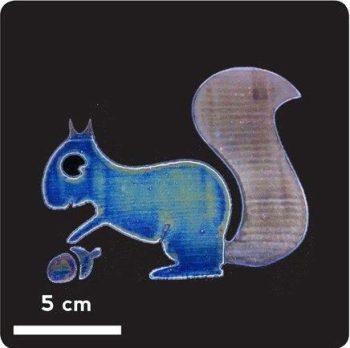Feb 11 2016
From dot-matrix to 3-D, printing technology has come a long way in 40 years. But all of these technologies have created hues by using dye inks, which can be taxing on the environment. Now a team reports in ACS Nano the development of a colorless, non-toxic ink for use in inkjet printers. Instead of relying on dyes, the team exploits the nanostructure of this ink to create color on a page with inkjet printing.
 This image of a squirrel was printed in color by controlling the thickness of a colorless ink deposited on a thin film. Credit: American Chemical Society
This image of a squirrel was printed in color by controlling the thickness of a colorless ink deposited on a thin film. Credit: American Chemical Society
Current technologies blend dyes — think CMYK or RGB — to print in color. But these substances can harm the environment. Some dyes are toxic to marine life or can react with disinfectants like chlorine and form harmful byproducts. An alternative to dyes involves changing the nanostructure of materials so that they reflect light in particular ways. An example of this kind of coloring by light interference is found in nature: Squids can modify the nanostructure of their skin to mirror back their surrounding environment, creating a natural camouflage. Previous research has investigated printing color by light interference, but these attempts have required high-temperature fixing or specialized printing surfaces. Aleksandr V. Yakovlev, Alexandr V. Vinogradov and colleagues at ITMO University wanted to develop a nanostructure color printing technology that is “greener” and can be printed on a wide variety of surfaces.
The team found that a colorless titanium dioxide-based colloidal ink was the best suited for the job. It does not require high temperature fixing and can be deposited on many surfaces. The researchers can control the color produced on surfaces by varying the thickness of ink deposition from a normal inkjet printer. Creating a vibrant color red with this method and this very narrow angle of coloring remains a challenge. This method, however, has generated the first reported “green” ink that is both safe for the ecosystem and does not fade from UV exposure, the researchers say.
The researchers acknowledge funding from the Russian government’s Ministry of Education and Science and ITMO University.